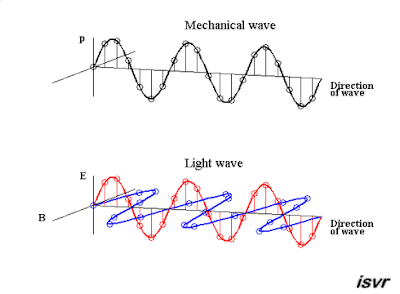In the article, we studies the motion of objects oscillating in isolation. What happens in a system, which is a collection of such objects? A meterial medium provides such as example. Here, elastic forces bind the consituents to each other and, therefore, the motion of one affects that of the other. If you drop a little pebble in a pond of still water, the water surface gets disturbed. The disturbance does not remains confirned to one place, but propagate outward along a circle.
If you continue dropping pebbles in the pond, you see circles rapidly moving outward from the point where the water surface is disturbed. It gives a feeling as if the water is moving outward from the point of disturbance. If you put some cork pieces on the disturbed surface, it is seen that the cork pieces move up and down but do not move away from the centre of disturbance.
This shows that the water mass does not flow outward with the circles, but rather a moving disturbance is created. Similarly, we speak, the sound moves outsward from us, without any flow of air from one part of the medium of another. The disturbance produced in air are much less obvious and only our ears or a microphone can detect them. These patterns, which move without the actual physical transfer or flow of matter as a whole, are called waves. In this article, we will study such waves.
In a wave; information and energy, in the form of signals, propagate from one point to another but no material object transmission of signals through waves. When we make a telephone 📱☎️ call to a friend at a distant place , a sound waves carries the massage from our vocal cords to the telephone.
Therefore, an electrical signal 🚦 is generated which propagates along the copper wire. If the distance is too lary, the electrical signal generated may be transformed into a light signal or electromagnetic waves and transmitted through optical cables or the atmosphere, possibly by way of a communication satellite 📡. At the receiving end, the electrical or light signal or the electromagnetic waves are transformed back into sound waves travelling from the telephone to the ear.
Not all waves required a madium for their propagation. We know that light waves can travel through vaccum. The light emitted by stars, which are hundreds of light years away, reaches us through inter- stellar space, which is practically a vacuum.
The waves we come across are mainly of three types:
- Mechanical waves
- Electromagnetic waves
- Matter wave
Mechanical waves are most familiar because we encounter them constantly; common example include water these waves, sound waves, seismic waves, etc. All these waves have certain central features: They are governed by Newton's laws and can exist only within a matterial medium, such as water, air, and rock. The common example of electromagnetic waves are visible and ultra violet light, radio waves, micro wave etc.
All electromagnetic waves travel through vaccum at the same speed.
Metter waves are associated with moving electrons, protons, neutrons and other fundamental particles, and even atoms and molecules. Because we commonly think of these as constituting matter. Such waves are called matter waves.
They arise in quantum mechanical description of nature that you will learn in your later studies. Through conceptually more abstract than mechanical or electro- magnetic waves, they have already found application in serveral devices basic to modern technology; matter waves associated with electrons are employed in electron microscopes.











